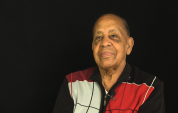8:57 | It was his 30th mission over Europe, and his most memorable. Dr. Harold Brown describes this mission where his plane went down and he had to bail out. Like many pilots who survived such an encounter, he was captured by the locals. Part 1 of 2
Keywords : Strafing Strafe Marshalling yard shot down bail out capture Germany

Dr. Harold Brown was raised in a multicultural neighborhood in Minneapolis, MN. They didn't have much during the Great Depression, but he remembers life being good for what it was. As a young man, he caught interest in flying, but getting lessons in those days for a teen would be an expensive undertaking.
As the war began, the effects hit close to home as his older brother would be sent overseas. It wouldn’t be long before the draft came for him too.
Dr. Harold Brown discusses the formation of the Tuskegee Airmen. Previously, black men had been prohibited from serving as pilots, but thanks to the advocacy of people like A. Philip Randolph and General Benjamin O. Davis, Jr., funds were set to train them to fly. This was only the first hurdle for them to overcome.
The initial class sizes were large, and Dr. Harold Brown remembers how many people were washing out. This new program was under a lot of scrutiny and the Tuskegee Airmen had a lot to prove, and their basic training would be the first step on a long journey.
Dr. Harold Brown describes one of the Tuskegee instructors, Gilbert Cargill, and one of his early flight experiences.
As the fires of WWII burned both in Europe and the Pacific, Dr. Harold Brown knew he’d be drafted, and enlisting would at least give him some better options in an assignment. He didn’t even know about the new program, but he was excited to learn that they were training new pilots, so he threw his hat in.
Once he had gotten enough flight hours under his belt, it was time for Dr. Harold Brown to move on to something a little more powerful. He describes moving into a P-40 Warhawk and learning the more complex maneuvers that would keep him alive overseas, as well as some of the men that made an impact on him during training.
The training took many weeks but Dr. Harold Brown was finally bound for Europe. He describes the journey overseas on their way to Ramitelli, Italy where he'd witness how dangerous war could be, even if he wasn't in combat.
Fighting against the Germans in Europe was nearing its conclusion in early 1945, but Dr. Harold Brown recalls still seeing some of their pilots and flak on his missions. He was tasked with protecting bombers so that they could destroy high-value targets and help Allied forces get closer to Berlin.
Dr. Harold Brown had a few missions under his belt, but on his twelfth mission he ran into a technical problem. Thanks to some quick thinking and good training, he was able to come out unscathed.
When they weren't flying, Dr. Harold Brown and the other airmen would pass time doing things like writing home or playing games. He describes one game of poker before one fateful mission where he'd get his hands on a very nice pair of boots.
Upon his capture, Dr. Harold Brown would be thrown into a cell alone until the Germans had gathered others to be sent to the prison camp. He recalls a moment where he would be under a strafing run much like he had been doing before, but luckily he survived it. His treatment wasn't great, but the war was coming to an end so he knew he just had to push through it. Part 2 of 2
The Germans took Dr. Harold Brown to Nuremberg where he'd be sat down in front of a well spoken Officer. He recalls the interrogation where the questions were quite specific, but he realized they could've gotten that information in any number of ways. Then, he was reminded that this war was coming to a close.
It took a couple weeks to get from Nuremberg to Stalag 13. When he arrived, there were already many enlisted-men taken prisoner, and their supplies were already running thin. As he figured, it wasn't long before General Patton came to liberate them.
He'd been liberated from Stalag 13 and the war in Europe had come to a close. Dr. Harold Brown was lucky to be alive, but he still had to wait for the C-47s to remove some of the other thousands of men from theater. Little did he expect, the journey home would be just as dangerous as the war itself.
Dr. Harold Brown spent a couple decades in the military after WWII, and recalls some of those experiences fondly, but wants people to know about the triumphs of the Tuskegee Airmen most importantly.